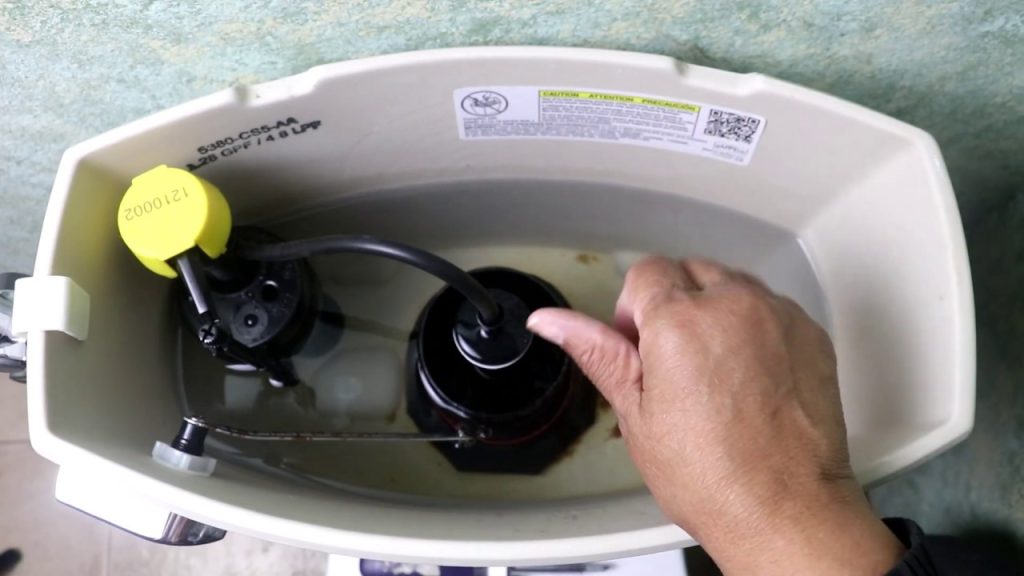A running toilet is annoying and wastes water. You can fix it quickly.
Dealing with a toilet that won’t stop running can be frustrating. It’s a common problem, but the good news is that you don’t need to be a plumber to fix it. With a few simple steps, you can stop that annoying sound and save water in just seconds.
This guide will walk you through the easy process, ensuring you can handle this household issue without any hassle. So, let’s dive in and learn how to stop a running toilet fast!

Credit: callfourseasons.com
Identifying The Problem
A running toilet can be annoying and wasteful. Identifying the problem quickly is key. By knowing what to look for, you can fix it in seconds. Let’s dive into the common causes and signs.
Common Causes
There are several reasons why a toilet keeps running. Here are the most common ones:
- Faulty Flapper: The flapper might not seal properly. Water leaks from the tank to the bowl.
- Float Issues: The float might be set too high. Water continuously flows.
- Fill Valve Problems: A defective fill valve may cause water overflow.
Signs To Look For
Spotting the signs of a running toilet can save you time and money. Here are the tell-tale signs:
- Hissing Sound: A constant hissing noise indicates water flow issues.
- Frequent Refilling: The tank refills often, even when not in use.
- Higher Water Bills: An unexpected spike in your water bill can be due to a running toilet.
Identifying the problem is the first step. Knowing the common causes and signs helps you act fast. Fix your running toilet quickly and efficiently.

Credit: www.familyhandyman.com
Gathering Necessary Tools
Fixing a running toilet doesn’t need a plumber. You can handle it yourself. Just gather the right tools first. Having the right tools makes the job quicker and easier. Here’s a list of basic and optional tools you might need.
Basic Tools Required
Before you start, grab these basic tools. They will help you fix the issue quickly.
- Adjustable wrench
- Screwdriver (flathead and Phillips)
- Plunger
- Bucket
- Rubber gloves
An adjustable wrench is crucial. You may need it to tighten or loosen nuts and bolts. A screwdriver, both flathead and Phillips, is essential for removing screws. A plunger can help if there’s a clog. A bucket is useful to catch any water spills. Rubber gloves keep your hands clean and safe.
Optional Tools For Easier Fix
Optional tools can make the job smoother. They are not necessary but can be helpful.
- Toilet tank repair kit
- Plumber’s tape
- Plumber’s putty
- Flashlight
- Old towels
A toilet tank repair kit includes various parts you might need. Plumber’s tape can seal small leaks. Plumber’s putty helps with sealing joints. A flashlight provides better visibility inside the tank. Old towels can soak up water and keep the area dry.
Turning Off The Water Supply
A running toilet can waste a lot of water. It can also drive up your water bill. The first step to fixing a running toilet is turning off the water supply. This simple action can stop the flow of water immediately. Let’s go through the process step-by-step.
Locating The Shutoff Valve
The shutoff valve is usually near the toilet. Most toilets have the valve located on the wall behind the toilet. Sometimes, it is on the floor. Look for a small valve connected to the water pipe.
If you cannot find it, check your home’s main water shutoff valve. This is often in the basement or near the water meter. Knowing where to locate the shutoff valve can save you time and prevent water damage.
Steps To Turn Off The Water
Once you have found the shutoff valve, turning off the water is easy. First, turn the valve clockwise. This will stop the flow of water to the toilet. If the valve is hard to turn, use a pair of pliers for extra grip. Turn the valve until it stops moving.
After you have turned off the water, flush the toilet. This will empty the tank and stop the running water. With the water off, you can now inspect the toilet. Check for any issues that might be causing it to run.
Fixing The Flapper
A running toilet can be annoying. Fixing the flapper is often the solution. The flapper is a rubber valve. It controls water flow from the tank to the bowl. Here, we will guide you through inspecting and replacing a damaged flapper.
Inspecting The Flapper
Start by removing the tank lid. Place it somewhere safe. Look at the flapper at the bottom of the tank. Check if it covers the flush valve snugly. A damaged flapper may not seal properly. This causes water to leak into the bowl.
- Check for visible cracks or tears.
- Ensure the flapper chain is not tangled or too short.
- Make sure the flapper is aligned with the valve seat.
Replacing A Damaged Flapper
If the flapper is damaged, replace it. First, turn off the water supply. Flush the toilet to empty the tank. Disconnect the old flapper from the flush valve. Remove the chain from the handle lever.
- Purchase a new flapper from a hardware store.
- Attach the new flapper to the flush valve.
- Connect the chain to the handle lever.
- Ensure the chain has a slight slack.
- Turn the water supply back on and test the flush.
A new flapper can stop the running toilet in seconds.
Adjusting The Float
A running toilet can be frustrating and wasteful. One common cause is an improperly adjusted float. The float controls the water level in the tank. Adjusting it can stop the toilet from running.
Checking The Float Level
First, remove the lid from your toilet tank. Look inside and find the float. It’s usually a ball or cup attached to a rod. The float should be level with the waterline mark on the tank.
If the float is too high or too low, it needs adjusting. A high float can cause water to overflow. A low float can prevent the tank from filling properly.
Modifying The Float Height
To adjust the float height, locate the adjustment screw or clip. Turn the screw clockwise to lower the float. This will reduce the water level.
Turn it counterclockwise to raise the float. This will increase the water level. Make small adjustments and check the water level each time.
Once the float is at the correct height, replace the tank lid. This should stop the toilet from running.
Examining The Fill Valve
Have you ever heard the sound of your toilet running continuously? It can be annoying and wasteful. One of the main culprits is the fill valve. Examining this valve can help you fix the problem in seconds. This guide will walk you through the process.
Inspecting For Issues
First, remove the tank lid and set it aside. Look at the fill valve inside the tank. Check for any visible damage or wear. Ensure the valve is securely attached and not loose.
Next, flush the toilet and watch how the fill valve functions. Is the water flowing smoothly? If the valve is not working correctly, it may need cleaning or replacement.
Cleaning Or Replacing The Valve
To clean the fill valve, turn off the water supply. This will prevent water from flowing into the tank. Then, remove the valve cap and inspect the inside for debris. Use a brush or cloth to clean any dirt or buildup.
If cleaning does not solve the issue, you may need to replace the valve. Purchase a new fill valve from a hardware store. Follow the manufacturer’s instructions for installation. Typically, this involves removing the old valve and inserting the new one.
Here is a simple table to summarize the steps:
| Step | Action |
|---|---|
| 1 | Remove tank lid |
| 2 | Inspect fill valve |
| 3 | Turn off water supply |
| 4 | Clean or replace valve |
By following these steps, you can stop a running toilet in seconds. It is a simple fix that saves water and reduces your utility bills.
Testing The Fix
After fixing a running toilet, it’s important to test it. This ensures the problem is solved. Testing the fix involves a few simple steps. First, turn on the water supply. Then, check for leaks. These steps confirm everything is working properly.
Turning On The Water Supply
To begin, locate the water supply valve. It is usually behind the toilet. Turn the valve clockwise to open it. This allows water to flow back into the tank. Listen for the sound of water filling the tank. It should stop when the tank is full.
Checking For Leaks
Once the tank is full, inspect the area around the toilet. Look for any signs of water leakage. Pay close attention to the base of the toilet and the connections. If you see any leaks, tighten the connections. If leaks persist, you may need to replace a part.
Next, flush the toilet. Watch the water flow into the bowl. Ensure the flapper closes properly after flushing. The tank should refill without any issues. If everything looks good, your fix is successful.

Credit: www.wikihow.com
Preventive Maintenance Tips
Keeping your toilet in good working order requires regular maintenance. By following some preventive maintenance tips, you can avoid the annoyance of a running toilet. These tips will help you save water and prevent costly repairs. Let’s look at some essential steps you can take.
Regular Inspections
Inspect your toilet parts regularly to ensure everything is in good condition. Check the flapper valve, fill valve, and flush handle. Make sure there are no leaks or worn parts. Look for signs of wear, rust, or corrosion. Catching issues early can prevent bigger problems.
Replacing Worn Parts
If you find any worn or damaged parts during your inspections, replace them immediately. Common parts that may need replacement include the flapper, fill valve, and flush handle. Purchase quality replacement parts from a trusted source. Follow the manufacturer’s instructions for installation. Replacing worn parts can keep your toilet running smoothly.
Frequently Asked Questions
How Can I Fix A Running Toilet Quickly?
To fix a running toilet quickly, check the flapper valve first. If it’s damaged, replace it. Adjust the float level and inspect the fill valve.
What Causes A Toilet To Keep Running?
A running toilet is usually caused by a faulty flapper, float, or fill valve. These components regulate water flow.
How Do You Adjust A Toilet Float?
To adjust a toilet float, locate the float adjustment screw. Turn it clockwise to lower the water level and counterclockwise to raise it.
Can A Running Toilet Increase Water Bill?
Yes, a running toilet can significantly increase your water bill. It wastes gallons of water daily, leading to higher costs.
Conclusion
Fixing a running toilet can be quick and easy. You save water. You save money. You gain peace of mind. Check the flapper, fill valve, and float. These are common culprits. Follow the steps, and your toilet will be quiet again.
No more annoying sounds. Simple tools and a bit of patience do the job. So, get started today. Your toilet will thank you. Enjoy a quiet bathroom once more.



